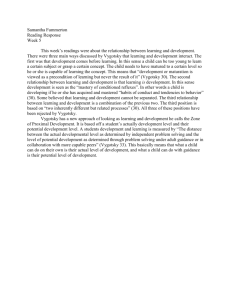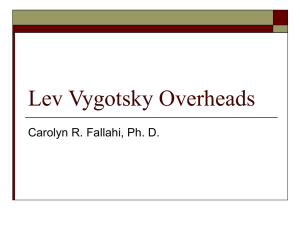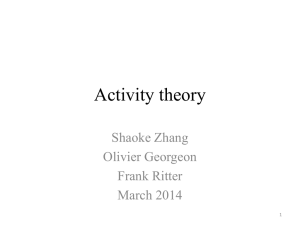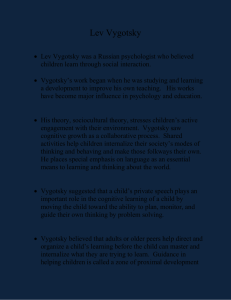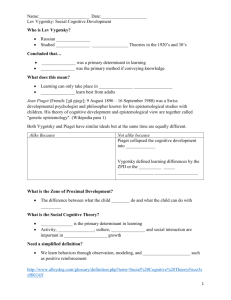Endnote for Lecture 4: The Problem of the Environment in... We remember that Vygotsky said, ...
advertisement
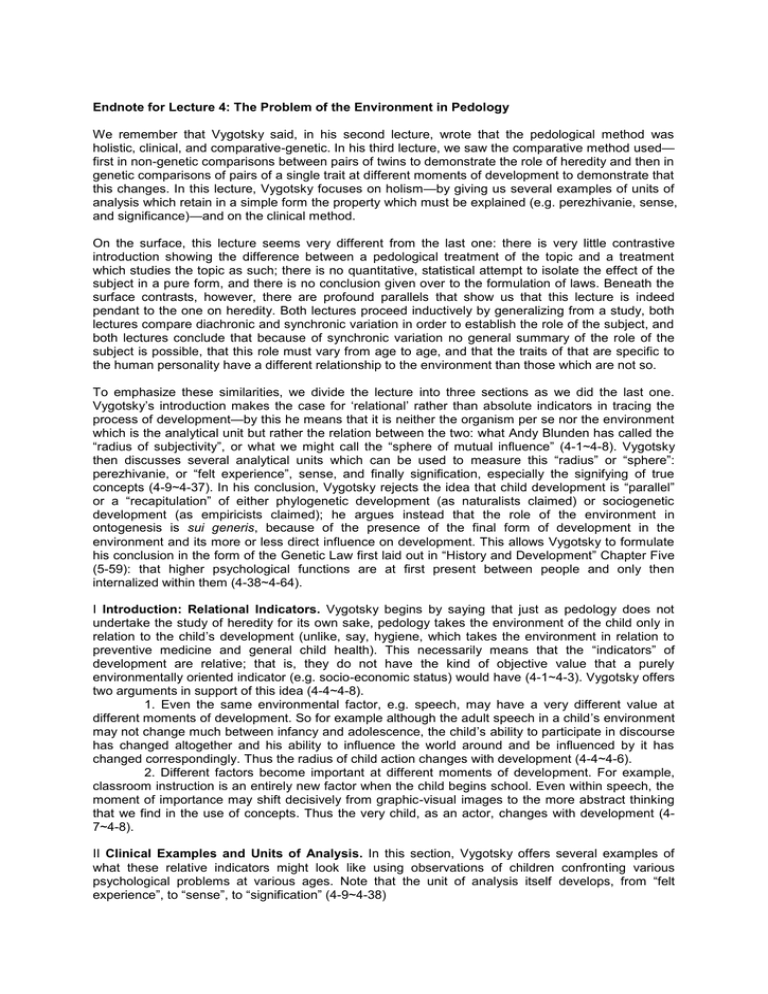
Endnote for Lecture 4: The Problem of the Environment in Pedology We remember that Vygotsky said, in his second lecture, wrote that the pedological method was holistic, clinical, and comparative-genetic. In his third lecture, we saw the comparative method used— first in non-genetic comparisons between pairs of twins to demonstrate the role of heredity and then in genetic comparisons of pairs of a single trait at different moments of development to demonstrate that this changes. In this lecture, Vygotsky focuses on holism—by giving us several examples of units of analysis which retain in a simple form the property which must be explained (e.g. perezhivanie, sense, and significance)—and on the clinical method. On the surface, this lecture seems very different from the last one: there is very little contrastive introduction showing the difference between a pedological treatment of the topic and a treatment which studies the topic as such; there is no quantitative, statistical attempt to isolate the effect of the subject in a pure form, and there is no conclusion given over to the formulation of laws. Beneath the surface contrasts, however, there are profound parallels that show us that this lecture is indeed pendant to the one on heredity. Both lectures proceed inductively by generalizing from a study, both lectures compare diachronic and synchronic variation in order to establish the role of the subject, and both lectures conclude that because of synchronic variation no general summary of the role of the subject is possible, that this role must vary from age to age, and that the traits of that are specific to the human personality have a different relationship to the environment than those which are not so. To emphasize these similarities, we divide the lecture into three sections as we did the last one. Vygotsky’s introduction makes the case for ‘relational’ rather than absolute indicators in tracing the process of development—by this he means that it is neither the organism per se nor the environment which is the analytical unit but rather the relation between the two: what Andy Blunden has called the “radius of subjectivity”, or what we might call the “sphere of mutual influence” (4-1~4-8). Vygotsky then discusses several analytical units which can be used to measure this “radius” or “sphere”: perezhivanie, or “felt experience”, sense, and finally signification, especially the signifying of true concepts (4-9~4-37). In his conclusion, Vygotsky rejects the idea that child development is “parallel” or a “recapitulation” of either phylogenetic development (as naturalists claimed) or sociogenetic development (as empiricists claimed); he argues instead that the role of the environment in ontogenesis is sui generis, because of the presence of the final form of development in the environment and its more or less direct influence on development. This allows Vygotsky to formulate his conclusion in the form of the Genetic Law first laid out in “History and Development” Chapter Five (5-59): that higher psychological functions are at first present between people and only then internalized within them (4-38~4-64). I Introduction: Relational Indicators. Vygotsky begins by saying that just as pedology does not undertake the study of heredity for its own sake, pedology takes the environment of the child only in relation to the child’s development (unlike, say, hygiene, which takes the environment in relation to preventive medicine and general child health). This necessarily means that the “indicators” of development are relative; that is, they do not have the kind of objective value that a purely environmentally oriented indicator (e.g. socio-economic status) would have (4-1~4-3). Vygotsky offers two arguments in support of this idea (4-4~4-8). 1. Even the same environmental factor, e.g. speech, may have a very different value at different moments of development. So for example although the adult speech in a child’s environment may not change much between infancy and adolescence, the child’s ability to participate in discourse has changed altogether and his ability to influence the world around and be influenced by it has changed correspondingly. Thus the radius of child action changes with development (4-4~4-6). 2. Different factors become important at different moments of development. For example, classroom instruction is an entirely new factor when the child begins school. Even within speech, the moment of importance may shift decisively from graphic-visual images to the more abstract thinking that we find in the use of concepts. Thus the very child, as an actor, changes with development (47~4-8). II Clinical Examples and Units of Analysis. In this section, Vygotsky offers several examples of what these relative indicators might look like using observations of children confronting various psychological problems at various ages. Note that the unit of analysis itself develops, from “felt experience”, to “sense”, to “signification” (4-9~4-38) A) Vygotsky takes a clinical cross section of three children in from the same domestic environment, namely an alcoholic mother who beats the children. The youngest is overwhelmed and usually silent or stuttering (4-12); the second child suffers from extreme ambivalent feelings of love for and terror of the mother (4-13), while the oldest shows symptoms of early maturity; neglecting schoolwork and play (and consequently giving the impression of a somewhat lifeless child), he has taken charge of the family (4-14). In this way, Vygotsky demonstrates that the same environment functions as a prism which reflects different spectra of light from the same experience (4-15~4-17). Vygotsky now lays out several units of analysis for psychological research that retain the properties of the psychological phenomenon as a whole, albeit in a highly simplified form (4-18). B) The first unit of analysis is “felt experience”, that is, the feeling of what happens.(4-19). Just as a word has both external sound and internal meaning, the “felt experience” is always an experience of something external to the experiencer, but it must always include the personality features of the experiencer as well. For this reason Vygotsky considers it a unity of environment and personality (420). Vygotsky gives several examples where the “sense” or the “significance” is not understood by the child: a mother’s deathbed, where the child is given sweets and kept amused (4-22), and a deformed child who is also mentally retarded and therefore unable to generalize the experience of being taunted by other children or to attribute it to his deformity and thus develop feelings of inferiority (4-23~4-25). C) The second unit of analysis is word meaning. Here especially we can see how one and the same speech event is reflected very differently in minds at different stages of development (4-26). Vygotsky remarks that a young child will think of meanings such as “street”, “person” or “weather” as referring to images of a highly concrete character, or factual and quite heterogenous relationships rather than to abstract and general concepts based on a single, homogenous, logical relationship equally applicable to all streets, all persons, and all weather. The child appears to think in “families”, where each person may have quite a different relationship to the head of the household or to the child (4-27~4-30). D) Vygotsky notes that much of what has been said up to this point concerns what the role of the environment is not: it is not homogenous, not uniform, not stable from age to age, and that it parallels what has been said about heredity (4-31~4-34). Vygotsky now wishes to characterize the role of the environment in positive terms and to talk about what is unique and specific to the environment (435~4-36). For this reason, he proposes to take traits which are maximally dependent upon the environment (just as geneticists take traits which are maximally dependent upon heredity in order study genetic laws in a pure form). And just as we found in the earlier chapter that it was lower psychological functions which had a more direct relationship to heredity, Vygotsky proposes that it is the higher psychological functions in general and the development of personality and consciousness in particular which should be investigated in order to reveal the role of the environment in a relatively pure form (4-37). III Conclusion: The Uniqueness of Ontogenesis and the General Genetic Law: In order to define the role of the environment in positive terms, Vygotsky turns his attention to the development of the personality and especially to speech (4-38~4-64). A) Vygotsky notes that what sets the ontogenesis of cultural behavior apart from phylogenesis and even sociogenesis is the presence and participation of a final form from the very onset of development. He gives the example of speech development: even an infant’s speech develops in a direct dialogue with the complete, albeit simplified, speech of the infant’s caretakers (4-39). Such a situation does not occur in phylogenesis; the earliest hominids were never confronted with fully developed humans (4-41). Nor does such a situation obtain in sociogenesis; hunter-gatherer societies do not take modernity as a model (4-42). Yet this situation does occur in ontogenesis. B) Vygotsky draws two important conclusions from this. 1. The environment is not the site but rather the source of development from all of the higher cultural functions, and they cannot develop normally unless the final form is present in some way in the environment (4-48). 2. Where children do develop without the appropriate final form in their environment, development is slow, idiosyncratic and arrested (4-49). C) Vygotsky illustrates these conclusions with three examples (4-50~4-56). 1. A deaf child who is not instructed in sign language or in lip reading cannot develop speech. Instead, a very idiosyncratic and rich system of gesture develops (4-50). 2. Orphans in nurseries are in general better at self-regulation, but they lag behind in speech development. This is because there is less interaction with adults than for children raised at home (451~4-53) 3. Children develop their own systems of counting and quantity, independent of instruction in arithmetic. But the development of this system is narrow, based, as we saw in “History and Development” on viso-graphic “numerical figures” (4-54). D) Vygotsky concludes the lecture by leaving the realm of pedology altogether. He declares that man is a social being, and that all of the qualities which divide him from other animals have developed in social interaction (4-59). For example, he says, speech is not invented individually; it cannot develop separately from social interaction (4-60). From speech, we develop self-directed speech and ultimately verbal thinking (4-64~4-65). This is merely one specific instance of a much more general law, the general Genetic law that stipulates the higher functions must develop between people before they can develop within them.
